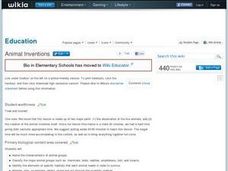Science 4 Inquiry
The Ups and Downs of Populations
Life has its ups and downs ... especially if you're an animal! Biology scholars engage in a population study through an inquiry-based lesson. Pupils work together to explore the factors that affect deer populations, then examine the...
Cornell University
Plant Cell Crime Scene
Use science to solve the mystery of the Poplar murder. Pupils use forensic botany to determine if a suspect could be the killer. By analyzing images from a Transmission Electron Microscope, learners determine if the material found on the...
Global Oneness Project
The Consciousness of Nature
Scholars voice their opinions about animal consciousness with an article that challenges common ideas about nature. After reading the article, learners engage in a thoughtful discussion before writing out their arguments in a persuasive...
Curated OER
Animal Body Parts for ESL
Students describe what animals look like. In this ESL vocabulary development lesson, students complete worksheets and use images to help them describe what animals look like.
Curated OER
Animal Inventions
Students name the characteristics of animal groups. Students classify the major animal groups such as: mammals, birds, reptiles, amphibians, fish, and insects. They identify the elements of specific habitats that each animal needs in...
Curated OER
Animal Adaptations: Focus on Bird Beaks
Sixth graders explore bird beaks as animal adaptation. In this bird adaptation lesson, 6th graders conduct an experiment to determine the connection between the shape of a bird's beak and the food it eats.
Curated OER
What is an Animal?
In this animal worksheet, students review characteristics of animals including body symmetry, development, and skeletal structure. This worksheet has 3 short answer questions.
Curated OER
Animal Behavior Word Search
In this animal behaviors word puzzle activity, students examine the 16 adjectives and names in the word bank and locate them in the word search puzzle.
Curated OER
Farm Animals
Why are farm animals important to the community? Expand young farmers' knowledge of furry and feathered friends through stories and a video. There are several books recommended; however, you could use any book about farm animals. A video...
Curated OER
Young Ones
This is the cutest reference materials activity ever! Researchers complete six sentences on baby animal names, continuing the pattern by writing five more sentences about other animals from their research. They use a thesaurus to look up...
Curated OER
Music: Sounds on the Farm
Singing is a great way to build memory, music, and verbal communication skills. Little ones sing the song, "Old Mac Donald had a Farm." They make the sounds of each animal on the farm paying attention to signaling cues, singing high, and...
Curated OER
A Matter of Survival
Fourth graders dance with inspiration from wild animals. In this creative movement lesson, 4th graders watch a video clip and then move like an animal might move in their natural surroundings.
Curated OER
Animals Galore
A well-designed instructional activity which covers the characteristics of the animals found in the six animal groups is here for your young biologists. In it, learners divide up into six groups; the amphibians, reptiles, mammals, birds,...
Curated OER
Habitat Basics
First graders get out and explore two different habitats to examine how each one meets the needs of the plants and animals that dwell there. They discuss what they've learned about animal habitats as they explore the outdoor environment....
Curated OER
Latin Lingo
Did you know that the Greek and Latin root words that make up the scientific name of a creature often describe the animal? All the root words on this list relate to whales and dolphins. Learners examine the scientific names for dolphins...
American Museum of Natural History
What's This? Breathing
Crazy fact: Some animals can survive months without oxygen. An online resource describes some unique ways animals collect oxygen and even live without it for an extended time. Learners read about these special animals and use pop-up...
Curated OER
What is an animal?
In this animal worksheet, students determine which characteristic of an animal matches the given statement. Students describe illustrations of animals using the terms radial symmetry, bilateral symmetry, and no symmetry.
K12 Reader
Animal Adjectives
How would you describe someone who was acting like a dog or a chicken? Teach your class the adjectives that pair with 20 different animals. They'll be able to describe anything canine or crocodilian, and everything in between.
Curated OER
Animal Kingdom Game
Students build their vocabulary and communication skills by describing animals found in nature. In this ESL lesson, students play a board game to compare and contrast animals. Students respond to icons, pictures and words to strengthen...
Curated OER
Animal Acrostic
In this animal acrostic worksheet, students read a short poem. Afterward, they answer questions about the poem and then write their own acrostic poetry. Students share their poetry with a friend, and guess what type of animal is described.
Curated OER
Types of Behavior: Animal Behavior Research
How does one determine what influences animal behavior; Is it nature or nurture? After a short reading explaining different types of conditioning and other learned behaviors, scholars examine six scenarios to determine whether the...
Civil War Trust
Civil War Animal Mascots
A pet can offer comfort, friendship, and loyalty in the most stressful of situations. Here is a lesson plan that explores the important role animals played during the Civil War. Class members read informative texts, complete a KWL chart,...
Scholastic
Study Jams! Air Masses & Fronts
Four types of air masses interact in the atmosphere above the US. The collision of these air masses forms a front, which, in turn, creates our weather. Concepts are explained by Sam and RJ, thus preventing a snowball fight. Your class...
Howard Hughes Medical Institute
Gorongosa: Making Observations Activity
Do you have young scientists wanting to make new discoveries rather than just completing the same experiments? Young scientists use their observational skills to identify animals and patterns in animal behavior. Through tracking...

























